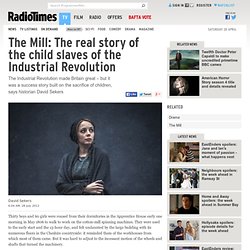

The Mill: The real story of the child slaves of the Industrial Revolution. Thirty boys and 60 girls were roused from their dormitories in the Apprentice House early one morning in May 1806 to walk to work on the cotton-mill spinning machines.

They were used to the early start and the 13-hour day, and felt undaunted by the large building with its numerous floors in the Cheshire countryside: it reminded them of the workhouses from which most of them came. But it was hard to adjust to the incessant motion of the wheels and shafts that turned the machinery. Thomas Priestley’s job that morning was routine: he had to look after one of the spinning machines.
Brought north from a workhouse in Hackney, east London, when he was ten years old, he’d been at Quarry Bank Mill for three years. “My business was to supply these machines, to guide the thread occasionally and to twist them when they snapped,” he later recalled. But then he lost concentration and disaster ensued. Greg could pick the fittest of these paupers in London, Liverpool, Cheshire and further afield. Health and Morals of Apprentices Act 1802. The Health and Morals of Apprentices Act 1802 (42 Geo III c.73), sometimes known as the Factory Act 1802, was an Act of the Parliament of the United Kingdom designed to improve conditions for apprentices working in cotton mills.

The Act was introduced in response to recommendations by physician Thomas Percival after an outbreak of "malignant fever" at a mill owned by Sir Robert Peel. The Act mandated that mills and factories provide proper ventilation, and required a minimum standard of cleanliness. It also regulated the treatment of apprentices, generally children, by limiting their working hours and requiring the provision of clothing. The Act also required that the apprentices be given a basic education and access to religion. Although it was ineffective, the Act's implementation paved the way for subsequent Factory Acts that would regulate the industry. Background[edit] Sir Robert Peel Percival's report made nine recommendations and observations for changes in factories and mills:
GCSE Bitesize: Working conditions in factories. Learning Zone Class Clips - Children Working in Coal Mines - History Video. Children in the Industrial Revolution. For one or two minutes think about your lifestyle now.

Make a few notes at the back of your exercise book about what you do now, how you spend your time, what you eat etc. Think about the number of times you have moaned about coming to school !! You are probably unaware but there are many laws that are directly linked to children your age. Not so much about what you can do but what you are not allowed to do. For example, did you know that children are not allowed down coal mines ?
Why were these laws brought in ? All the following passages are primary source evidence. Child labor in Factories During the Industrial Revolution. 1.

"The Industrial Revolution, 1700-1900. " DISCovering World History. 1997Student Resource Center. Framington Hills, Mich.: Gale Group. Online Database. November 8, 2001 2. 3. This is a primary source because it is a collection of actual interviews from the time period. 5. 6.